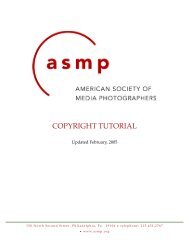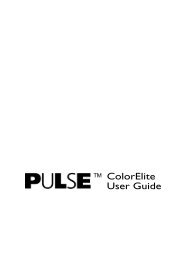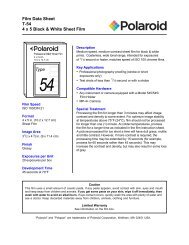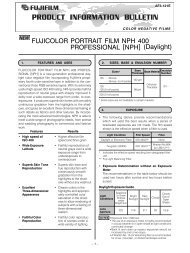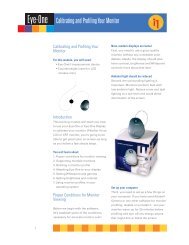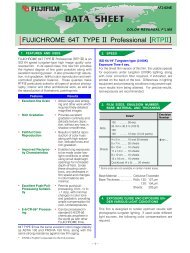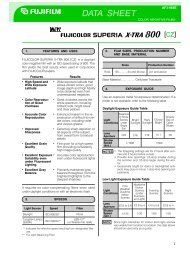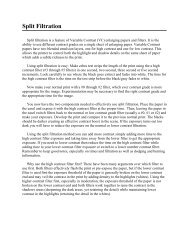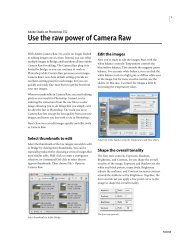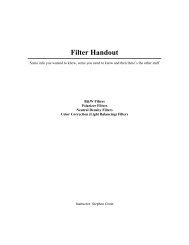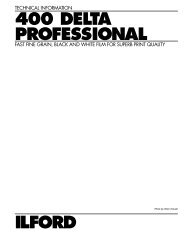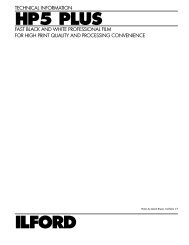FUJICOLOR NPH 400 PROFESSIONAL [NPH] - Fujifilm USA
FUJICOLOR NPH 400 PROFESSIONAL [NPH] - Fujifilm USA
FUJICOLOR NPH 400 PROFESSIONAL [NPH] - Fujifilm USA
Create successful ePaper yourself
Turn your PDF publications into a flip-book with our unique Google optimized e-Paper software.
<strong>FUJICOLOR</strong> <strong>NPH</strong> <strong>400</strong> <strong>PROFESSIONAL</strong> (<strong>NPH</strong>) • FUJIFILM DATA SHEET<br />
6 LONG AND SHORT EXPOSURES<br />
No exposure or color balance compensation is required<br />
when exposure time is within a 1/<strong>400</strong>0 to 1 second.<br />
However for exposures of 4 seconds or longer, exposure<br />
compensations are required.<br />
Exposure<br />
Time (sec.)<br />
Color<br />
Compensating<br />
Filter<br />
Exposure<br />
Correction<br />
(Lens<br />
Opening)<br />
1/<strong>400</strong>0 to 1<br />
None<br />
None<br />
4<br />
None<br />
+ 1/2 stop<br />
16<br />
None<br />
+ 1 stop<br />
(Exposure time longer than 16 seconds is not recommended.)<br />
7 FILM HANDLING<br />
• Unprocessed film must be handled under conditions<br />
of absolute darkness without safelight illumination.<br />
• Expose and process before the expiration date indicated<br />
on the film package and process promptly after<br />
exposure.<br />
• When loading and unloading roll film avoid direct<br />
sunlight. If there is no shade, turning one's back toward<br />
the sun will shade the film.<br />
• Camera-loaded film should be exposed and processed<br />
promptly.<br />
• Under certain conditions the X-ray equipment used<br />
to inspect carry-on baggage at airport terminals will<br />
adversely affect photographic film (cause fogging).<br />
The adverse effects of this are increased with the<br />
strength of the X-rays, the speed of the film, and the<br />
cumulative number of inspection exposures.<br />
Therefore it is recommended that at each inspection<br />
the film be removed from the baggage and that airport<br />
security personnel be asked to inspect the film<br />
manually.<br />
• Film fogging may occur in hospitals, factories, laboratories<br />
and other locations using X-rays and other<br />
radiation sources.<br />
8 FILM STORAGE<br />
Unprocessed Film<br />
• Storing exposed or unexposed, unprocessing film<br />
under high temperature and humidity conditions will<br />
cause adverse speed, color balance and physical<br />
property changes. Store film under the following<br />
conditions.<br />
⎧<br />
⎨<br />
⎩<br />
Ï Refrigerated Storage: Below 10°C (50°F)<br />
Ï Extended Term Storage: Below 0°C (32°F)<br />
• New building materials, newly manufactured furniture,<br />
paints and bonding agents may produce noxious<br />
vapors. Do not store film, loaded camera or<br />
film holders near these substances.<br />
• When refrigerated film is removed for use, allow it<br />
to reach room temperatures before opening (at<br />
least one hour or two). Opening while temperatures<br />
are still low may cause moisture condensation.<br />
Processed Film<br />
Light, high temperatures and humidities cause color<br />
changes in processed films. Therefore, place such<br />
films in mounts or sleeves and store in dark, dry, cool<br />
and well ventilated locations under the following conditions.<br />
⎧ Ï General Storage Conditions:<br />
⎪ Below 25°C (77°F) at 30 to 60% RH<br />
⎨<br />
Ï Extended Storage Conditions:<br />
⎪<br />
⎩ Below 10°C (50°F) at 30 to 50% RH<br />
9 PROCESSING<br />
This film is intended for processing in FUJIFILM Process<br />
CN-16, Kodak Process C-41 or equivalents.<br />
10 NEGATIVE EXPOSURE EVALUATION<br />
<strong>NPH</strong> exposure adequacy can be accuratery estimated<br />
by using an electronic densitometer equipped with Status<br />
M filters. When read through the RED filter, an<br />
18% gray card receiving the same illumination as the<br />
subject, should render density reading between 0.78<br />
and 0.98. These densities are for exposures made under<br />
recommended light sources and with optimal film<br />
processing.<br />
11 PRINTING<br />
This film can be printed on materials made by<br />
FUJIFILM or other manufacturers, including<br />
<strong>FUJICOLOR</strong> Professional papers for prints, and<br />
FUJITRANS SUPER FA Display Material for display<br />
transparencies.<br />
12 RETOUCHING<br />
120/220 <strong>NPH</strong> negatives can be retouched on both the<br />
base and emulsion surfaces. Retouching characteristics<br />
are similar to other professional color negative<br />
films.<br />
3


![FUJICOLOR NPH 400 PROFESSIONAL [NPH] - Fujifilm USA](https://img.yumpu.com/27607653/3/500x640/fujicolor-nph-400-professional-nph-fujifilm-usa.jpg)
